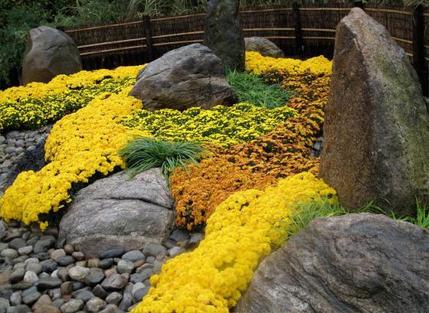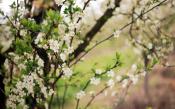Search
Login
We create a rock garden with our own hands, what is it, how to make a rock garden correctly
The stone has long been associated with serenity and tranquility. The object of inanimate nature, excluding any notions of existence, in ancient philosophy was endowed with special qualities, inspired and used as an object of worship. Such a philosophical direction was the philosophy of the East, namely Confucianism and Buddhism, otherwise called the philosophy of inaction or the philosophy of contemplation.
Content
- Japan is the birthplace of rock garden
- Stone - a cult trend in landscape design
- Creating a rock garden video
- Rock Garden of Ryoanji Temple
Japan is the birthplace of rock garden
The philosophy of stone and rock gardens originated in Japan, in connection with the emergence of a new religious trend called Zen Buddhism.

A new kind of garden was the apogee of symbolism, where the stone seemed to be an object endowed with a special energy. In fact, he combined the whole essence of the universe.

Stone - a cult trend in landscape design
Currently, the stone not only does not lose its popularity, but also more and more often becomes a cult direction in landscape design.

This is due both to the growing eastern culture, and to the desire to at least a millimeter closer to nature, breathing in its blissful aroma. In modern landscape design, the stone loses its sacred component, and its aesthetic advantages come to the fore.
A reverent attitude towards the stone has been preserved to this day, daily watering with subsequent observation of the play of chiaroscuro on various stone faces is the best evidence of this.


The rock garden is a stylistic composition, which each of us can organize. If you are reading this article, then you are interested in the answer to the question: How to make a rock garden with your own hands ?, and today, you will understand that it is not so difficult.

Creating a rock garden
Creating a rock garden with your own hands must begin with the choice of stones.

stone selection
First of all, when selecting a stone, attention should be paid to its shape. And here it should be added that it is desirable to use all elements of the composition in groups, as this will allow to hide single defects.

The next important characteristic of the stone is its natural appearance. And here it is recommended to give preference to stones that were previously exposed to climatic effects. Their natural harmony, soft round features will create an atmosphere of peace in your garden and allow you to concentrate on contemplating the world. Stones, in the outlines of which there are hard edges and chips, are inferior in this to the previous ones.

Then it's time to pay attention to color specifications. The color spectrum of natural stones varies from brownish to violet, but a combination of stones that are close in color will be a conceptually beneficial solution, as this will not violate the calm atmosphere that we originally sought.
Also, one cannot fail to take into account the hardness of the stones used and the presence of foreign inclusions.

compositional options
Decorative stones for the garden are selected, and it is time to go directly to the consideration of the compositional options themselves.
This stage is no less important, since the relative position of the elements in the rock garden, the photo of which is presented below, also has a significant impact on the harmony of the surrounding space.
Before deciding on the method of arranging the stones, it is necessary to present the desired result and the goal that you pursue when creating the composition. But the main point, which should not be forgotten, is the deliberate loss of frontal compositions, as they upset the balance and dynamic balance.

principles of composition
There are several basic principles for arranging elements in a Japanese rock garden.

The first and most important principle is the orientation of the entire composition of the Japanese garden around a single point of contemplation.
This point is selected in accordance with the time of day that you plan to spend in the garden. Usually the point of contemplation is located on the north side, but various variations are also expected.
Another principle that European garden designers need to consider is the need to maintain the contrast between free and full space, and since people of the Caucasian race are not used to this state of things, this is indicated in our article.

We must not forget about the asymmetry as the main condition of the garden. It is so important that Japanese designers even consider the reflection of objects in the water and their shadows.
An odd number of elements is also the basis of the Japanese garden. Ideally, objects of composition should be oriented in accordance with the correct geometric heptagon, which is symbolic in Japanese culture.

Japanese designers advise maintaining a balance of vertical and horizontal lines when creating a composition. Horizontally located stones should prevail over vertically standing. This is necessary because there are a lot of vertical lines in the garden, these are trees, buildings, and fences. The horizontal orientation of the stones should dilute the verticality of the remaining structures.

complement the garden design with various elements
It is a mistake to believe that stones are the only elements of the Japanese garden. The landscape of the garden is represented by various compositional structures.
Among them are paths, and fences of various shapes, and stone statues and tsukubai, which are original elements of the Japanese garden.

Walkways are an essential attribute of a rock garden. Their soft, sinuous shape only emphasizes the harmonious atmosphere of the garden, and the beauty and originality of the material is skillfully masked by landscape designers so as not to upset the balance of simplicity and regal grandeur.

The presence of a fence in the Japanese garden determines the desire for solitude and tranquility, in connection with which, the main principle of their structural organization is opacity.
Tsukubai, which is currently an additional decorative element, was originally used to wash hands before the tea ceremony. They are stone bowls, 20-30 cm high.

Rock Garden of Ryoanji Temple
One of the famous gardens is the rock garden of the Ryoanji Temple in Kyoto. Being a historical monument, a stone garden was created between the 14th and 16th centuries. At the moment, this is one of the most important shrines of Zen Buddhism.
The garden is a rectangular area, the territory of which is made of gravel. The main composition of the garden are fifteen stones, the location of which is clearly structured. As mentioned above, the platform on which the garden is located is lined with a layer of gravel, the surface of which is streaked with wavy lines. These lines are drawn with a rake and symbolize the water element.

All fifteen stones are divided into five groups. And if previously specialists in historians and cultural studies did not identify any definite idea in this composition, then at the moment their ideas are directly opposite.

An unsystematic composition of stones and moss suddenly lined up in their minds in a clear structure that resembled the outlines of tree branches, and if you look at it from a certain angle, you can see a tree. But on this, the riddles of the main attractions of Kyoto are not solved. Scientists still have not been able to understand what the hypnotic effect of this composition on human consciousness is based on, because it is possible to comprehend the idea of \u200b\u200ban unknown master only in silent contemplation.






